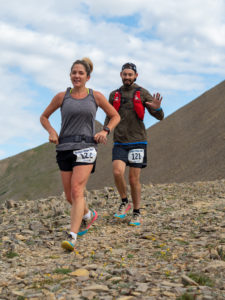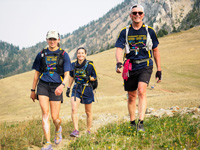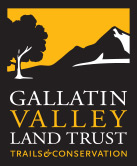by Rob Maher and 2015 Sweep Crew
Bridger Ridge Run 2003 from Bridger Ridge Run on Vimeo.
Course directions:
The course is officially (GPS) 19.90 miles, so long as you take the “quick” way down from the “M” and don’t make too many detours during the race. The longer way down makes it 20.55 miles. Total elevation gain is 6,800 feet, with a 9,500 foot loss. If you have run the course before, you don’t need a map. If this is your first time on the Ridge, you are well served to get all the help possible. Maps (photocopies of USGS Topo maps) will be available at the Orientation Meetings. We run on the Sacagawea Peak, Saddle Peak, and Kelly Creek USGS 7.5 minute series topo maps. Here are a few pointers for those wishing to practice on their own before the race:
The first 2.25 miles climbs a 1,800 feet vertical rise on a decent trail to the summit of Sacagawea. There will be race personnel on the actual summit, taking down your race number on their check sheets. Failure to get checked-off (missing the peak, not letting them see your number, etc.) will result in disqualification. You must be patient as you approach the summit – there will be a long line – there’s no other alternative. We MUST know who made it to the top, and who is on their way to Ross Pass. If you get missed, then you’re out of the race. After Sacagawea, the trail traverses across the South Peak and down to a saddle on the ridge. You will find a 4 foot high “chimney” cairn of rocks which marks where you turn right off the ridge to gain the Foothills Trail. This is a steep loose rock drop, which traverses back and forth until you hit the well- maintained Foothills Trail. This is followed until you come out onto Ross Pass. This trail drops and gains elevation at will – there is no other trail around – keep following it. If there is dense fog or low clouds during the race, we often lose people when they come into the meadows of Ross Pass. The checkpoint is at the far end of the pass, and a good trail does head left, then up and over the pass and down Brackett Creek to Bridger Canyon Road. Don’t do that! Find the aid station, get checked-off, get refreshed, and hopefully you’re on your way before 10am!! If you have encountered physical problems at this stage of the race (this first 1/3rd of the race is the most challenging), now is the time to bag the race, and go down to vehicles waiting a mile down from the pass.
After the Ross Pass Aid Station, you go about 1/4 mile into the forest and find a Ridge Run Cut-off trail that heads left back up the ridge. The rise is about a 1000 foot gain – and the trickiest, footing-wise. Follow markers – look for orange flagging in trees or on rocks, whenever you’re not sure where the trail is. Much of the trail is on talus, with no clear trail to follow. Besides contouring around some impassable cliff sections, this trail does pretty much stay on top of the ridge, if you ever have to make a choice. The Bridger Aid Station cut-off time of 4 hours 15 minutes is pretty tough if you’ve left Ross Pass at 10am. The only other tricky area is approaching Bridger Peak – there is an obvious trail that goes left of the peak – that is a dead- end. Stay to the right of the peak. After Baldy, after you make the initial drop off the peak, there is a main trail that veers off to the right and down into Sypes Canyon. Motor bikes use this trail, and it is well-used. Don’t go that way. Look for the cut-off that goes straight ahead, instead of veering off to the right. Stay on the Ridge all the way down. Once you get to the “M”, there are only 2 official ways down – the longer way to the right at the bottom of the “M”, or the steep version which angles left at the bottom of the “M”. Don’t use the abandoned gully (original trail) which is off-bounds, and will result in instant disqualification!
New for 2022, the course diverts to runner’s right (west) just above the “M” trailhead, and cuts on a mowed path across the field, to intersect and cross the bike path, where the highway underpass tunnel takes you to the Drinking Horse Mountain trailhead, on the south side of the highway. The course crosses this parking lot, heading SE, then takes a short trail ending at the new finish line at the W end of the Fish Hatchery lawns.
Maps:
Garmin/Google Earth (with elevation profile)
PDF topo maps still to come
Checkpoints:
Your race numbers MUST be completely visible on your front when going through the 4 checkpoints. The race is designed to finish at 2:30 pm, or at 8 hours of running. Any later than that puts the race and volunteers in a tricky position with regards to afternoon thunderstorms. We need to get all personnel off the Ridge by 2:30 pm. To make this happen, the cut-off times are STRICTLY enforced. If you fail to make a deadline, you will be asked to stay at the checkpoint and to come down off the mountain with a race personnel. You will be escorted to the finish line, so the race officials can check you off as having officially gotten off the mountain. Any disregard for any of these “rules” will result in not being able to enter any future Ridge Runs.
You must be at the following checkpoints at the following times in order to continue the race:
- Sacagawea – 1:15 from the start plus 20 min for 5 waves (8:05 am)
- Ross Pass – 3:00 from the start plus 20 min for 5 waves (9:50 am)
- Bridger Bowl – 4:15 from the start plus 20 min for 5 waves (11:05 am)
- Finish Line – 2:30 pm
Aid – Water Stations:
These Aid Stations are supplements to what you are already carrying yourselves. Everyone should start the race with full bottles/camelbacks and lots of their own snack materials. There are 3 official Aid Stations: Ross Pass, Bridger Bowl, and Mt. Baldy. These will have ample water available – enough to take a drink, and fill your water bottles – at least a full quart. A limited amount of water will be carried to Sacagawea by the volunteers the morning of the race – a cup apiece. There is also what we call “an emergency aid station” Â1⁄2 way down from Mt. Baldy. Here, we will have water, gatorade, cookies, candy – as a help to those struggling down the last couple miles. For those not needing any supplies, please just run by this station. We will have over 70 gallons of water at the main stations, but only about 20 gallons here. There will be basic 1st Aid supplies available, though you are responsible for the correct application of these materials. Runners can leave excess clothing/equipment for the volunteers to carry down for them – but the retrieval of such items at the post race party is always in question.
Equipment and Clothing:
The weather can be extreme, the footing hazardous, and it is a long way between snacks and water. Bring your own cold weather gear to the start – in case you need it (it’s a lot colder on Sacagawea than at the finish). Plan on carrying a rain/wind shell, gloves, knit hat, map, water, and snacks. There are excellent padded belts commercially available to carry these items. You may want to start the race with a long sleeve shirt to keep you warm until the sun comes up with a singlet/T-shirt, with number attached, over it. Shoe preference is very individual. You need good support and cushioning. A good trail shoe is best – not hiking boots. Run on similar terrain for your training well before the race to find out what works best for you.
Safety:
Safety is our paramount concern. There will be a sweep team bringing up the rear, and radio or telephone contact is maintained between that team, the checkpoints, and the race director. If you are injured too badly to continue, stay on the marked trail and wait for the sweep team. They will have whatever is necessary to help you. Under NO circumstances should a runner leave the course except under the direction of the race support personnel. If you can walk comfortably but feel you cannot finish the race, walk to the next aid station. Do not attempt to finish if you are severely injured. If severe weather occurs (thunderstorms, high winds, extreme cold, accumulating snow) stay off the ridge top but stay within sight of the course. If you get lost after Ross Pass, go back up to the top of the ridge – you should be within sight of the sweep team as they come along. Before Ross Pass, keep looking for the Foothills Trail on the Bozeman side of the Ridge. The Race Director reserves the right to cancel or stop the event in case of extreme weather conditions. If lightning strikes nearby, get off the top of the Ridge! Your main concern should always be: proper pacing, adequate clothing, proper hydration/caloric intake. PLEASE, if your physical condition is in any way questionable on race day, do not participate in the race!!








